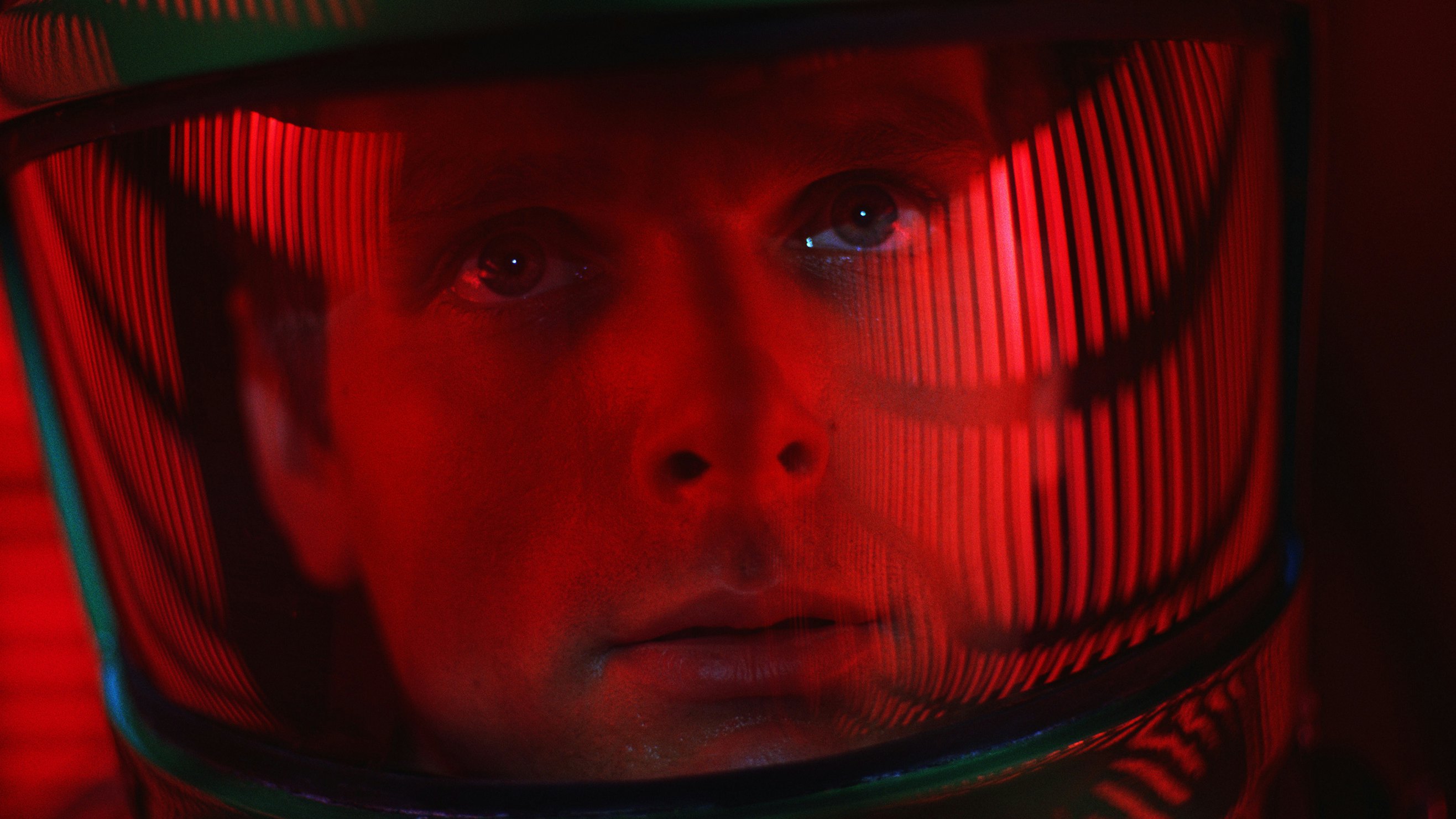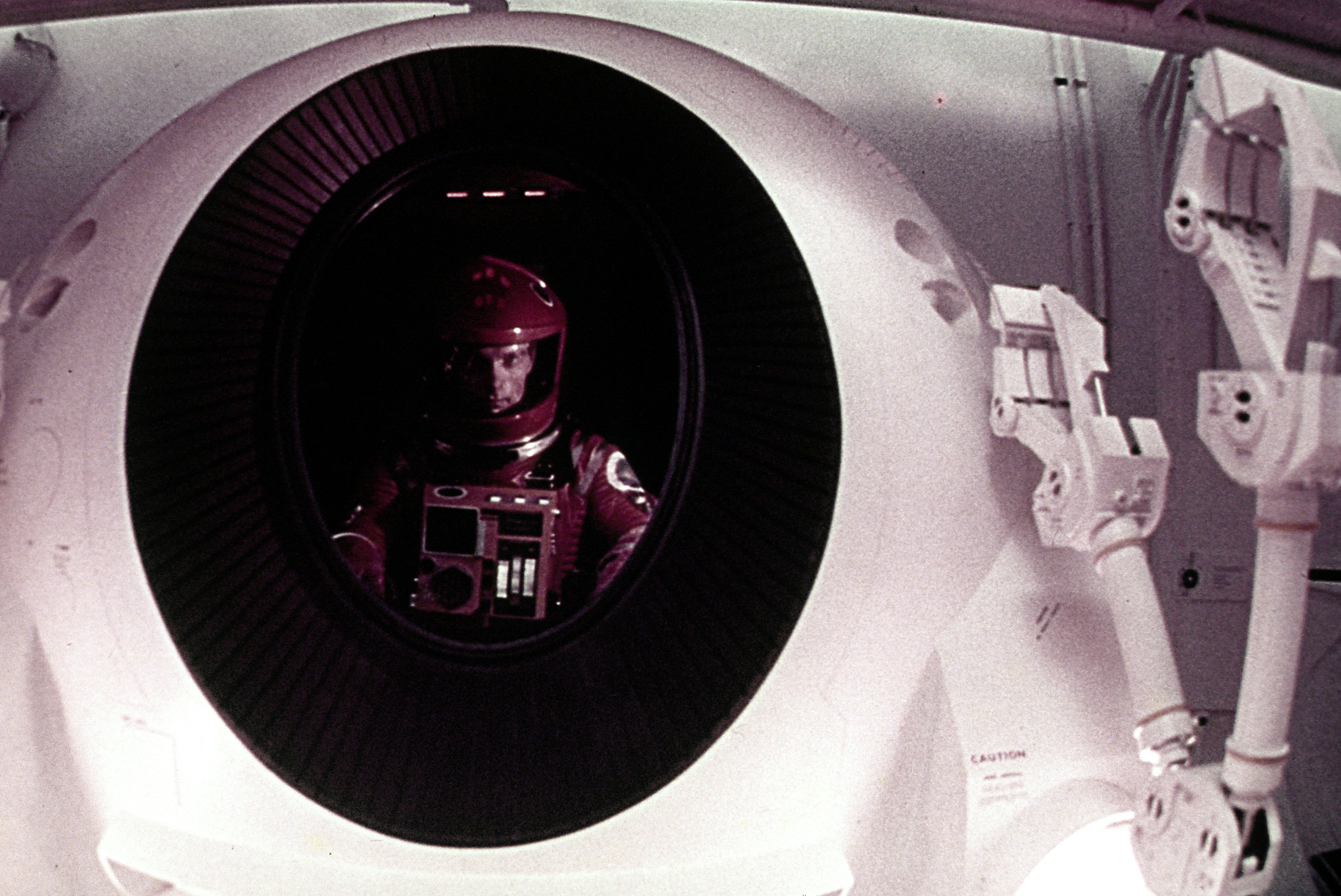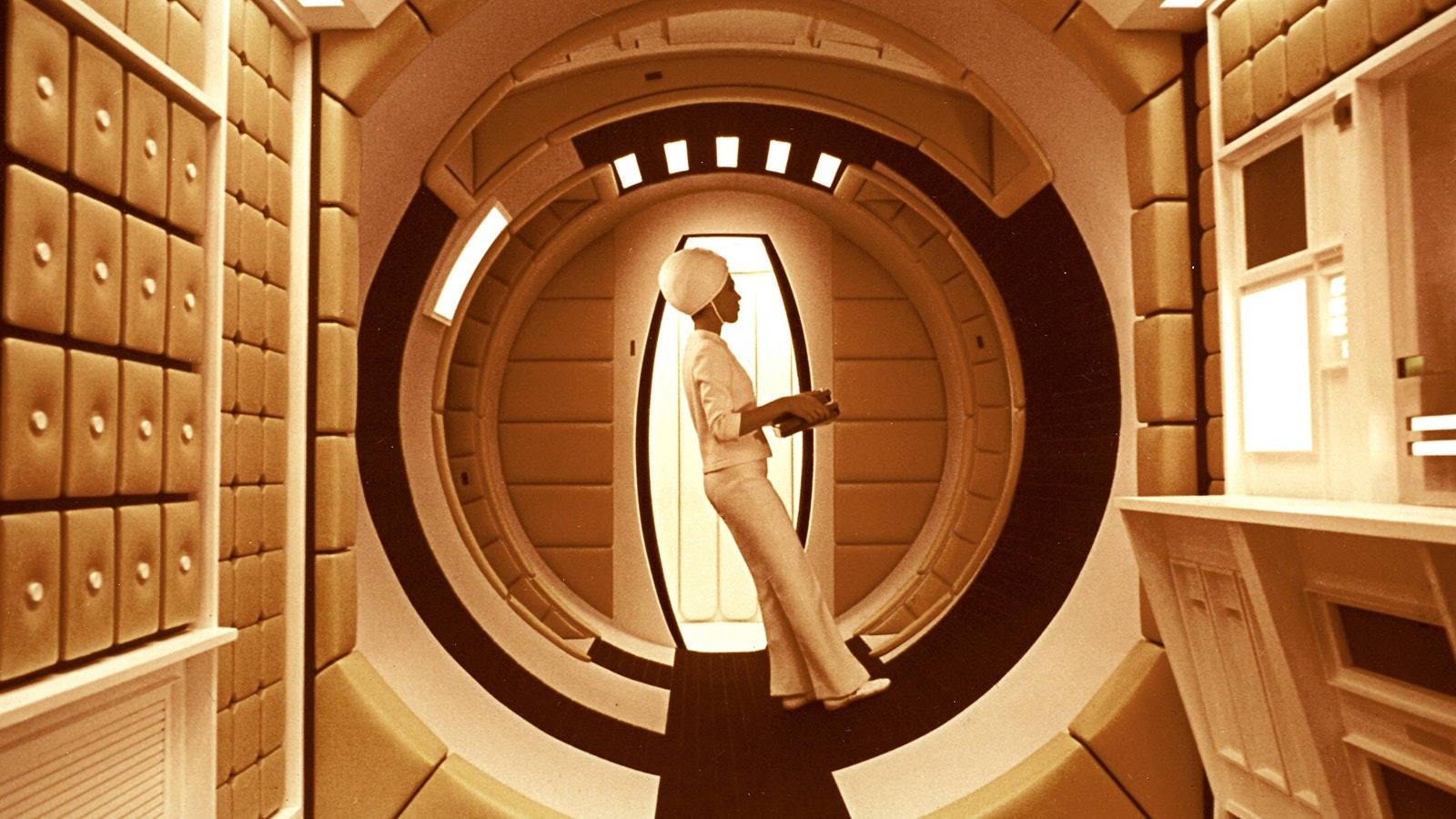
A year before the Apollo 11 Moon landing in July, 1969, Stanley Kubrick’s 2001: A Space Odyssey was released in theaters. A cult masterpiece of cosmic proportions, 2001 imagined a near-future in which humans went on epic interplanetary journeys assisted by hyper-intelligent machines. It remains one of the wildest and highly-stylized sci-fi films ever made, yet 2001: A Space Odyssey is also one of the most accurate depictions of aeronautical technology to date.
Jonathan McDowell, an astrophysicist at the Harvard-Smithsonian Center for Astrophysics, argues that 2001 is in a league of its own when it comes to accurately depicting space travel.
“I think it's the only science fiction movie to capture the majesty and precision of travel through space,” McDowell tells Inverse.
2001 is two hours and 19 minutes long, with just under 40 minutes of dialogue. The famously pedantic Kubrick left little to chance; and his meticulous focus on technology was no exception – it is vital to the film’s theme. In a 1968 interview with Eric Norden from Playboy, Kubrick explained his intention behind 2001: “I tried to create a visual experience, one that bypasses verbalized pigeonholing and directly penetrates the subconscious with an emotional and philosophic content ... in 2001, the message is the medium.”
“Sending them to the Moon? No problem.”
The experience Kubrick was trying to create was no small feat; he was trying to capture something that is quite difficult to grasp universally … but attempting to put it into words almost detracts from its magnitude, vastness, and complexity. That is sort of Kubrick’s point. And one of the most essential ingredients for creating that experience: technology.
“I will say that the God concept is at the heart of 2001 — but not any traditional, anthropomorphic image of God,” Kubrick said. “I don't believe in any of Earth's monotheistic religions, but I do believe that one can construct an intriguing scientific definition of God… When you think of the giant technological strides that man has made in a few millennia — less than a microsecond in the chronology of the universe — can you imagine the evolutionary development that much older life forms have taken...Their potentialities would be limitless and their intelligence ungraspable by humans.”
Principal engineer at NASA’s Jet Propulsion Lab John Brophy saw the film when it came out in 1968. He tells Inverse that it opened his eyes to the possibilities of space travel — and making these dreams come true.
“I thought it was really fantastic. And the cool thing was, it really made it seem like, you know, sending people to Jupiter was realistic,” he says. “Sending them to the Moon? No problem.”
Even the plane-like shuttle that takes people to the Moon is a realization of Kubrick’s vision, Brophy comments: “because the Space Shuttle has wings.” From the moonwalk to the design of Discovery One (the ship that travels from Earth to Jupiter using nuclear propulsion controlled by a murderous AI called HAL 9000), 2001 is one of the most scientifically well-researched films in history — and one of the most prescient.
Working with NASA to Design 2001: A Space Odyssey

In the making of 2001, Kubrick’s consultants had already been working with NASA, and continued once production began. Frederick Ordway III, a researcher and science communicator, and Harry Lange, a German designer who worked for the military and for NASA were the lead guys responsible for the creativity and accuracy of the technology in the film. They had worked closely with Wernher Von Braun, referred to by some as a “Father of Rocket Science,” in the past.
Von Braun, who emigrated from Germany to the U.S. after World War II, was largely responsible for the creation and development of V-2 ballistic missiles. At NASA, he was a huge advocate for space exploration. His group built the rocket that carried the first American, Alan Shepard, into suborbital flight in 1961 on Mercury-Redstone 3. He may also have been the partial inspiration for Kubrick’s 1964 film, Dr. Strangelove or: How I Learned to Stop Worrying and Love the Bomb. Even though Von Braun and Kubrick never worked together directly, Kubrick certainly benefited from existing within Von Braun’s orbit.
In a written retrospective, Ordway describes his first meeting with Kubrick. He and Lange met him through Arthur C. Clarke, who was staying at the Chelsea Hotel in New York City when Ordwell and Lange happened to be visiting the city. He recalls how Clarke talked about Kubrick’s vision: “First of all, [Kubrick] wanted to create the space fiction film, one against which all others would be measured. It would-be a big budget, big screen effort, serious, and scientifically and technically plausible,” Ordway writes. “It would portray man facing the immensity of the universe and consider the possibility that life may exist out among the stars. Lange and I listened attentively.”
The Realism of The Discovery One

Ordway describes six months of pre-production planning and design work that resulted in the evolution of six space vehicles – an Earth-to-orbit shuttle, a space station in orbit around Earth, an Earth-orbit-to lunar surface shuttle, a lunar surface transport bus, the Discovery One, and its associated pod. Ordway and Lange were as meticulous as Kubrick. He described leaning heavily on NASA and private companies for advice and material to support their work on designing and building the technology featured in 2001.
According to Brophy, the Discovery One is one of the most impressive aspects of 2001’s true-to-science representations of aeronautical engineering: “That's a very realistic depiction of what a crewed piloted ship to Jupiter might look like.” He explains that a nuclear ion propulsion spaceship would need to be long like the Discovery One to keep the humans at a safe distance from the radiation generated by the nuclear propulsion system.
He does, however, say something key is missing from the iconic ship.
“Any kind of large spaceship that processes a lot of power would have to get rid of a lot of waste heat. So, there would be fairly large thermal radiators; just surfaces that get hot and then radiate that heat out into space,” explains Brophy. “It turns out that the makers of the movie and Kubrick knew that, but were afraid that if they put these radiators on, they would look like wings, which they would. They didn't like that, so just for aesthetic reasons did not include the radiators.”
In other words, the ship wouldn’t look so cool.
The details were not arbitrary additions. In his retrospective, Ordway recalls, “each of these vehicles was designed with extreme care, for we would later be dealing with full-scale interiors as well as reduced-scale exterior models all of which had to appear absolutely realistic. We insisted on knowing the purpose and functioning of each assembly and component, down to the logical labeling of individual buttons and the presentation on screens of plausible operating, diagnostic and other data.”
A Surprisingly Accurate Depiction of Space

Brophy, an aeronautical engineer by training, was particularly amused with the Zero Gravity Toilet located on Space Station V based on a concept by von Braun, the midway point between Earth and the Moon. This was extremely true to form, Brophy says. Kubrick has also claimed this was the only intentional joke in the film.
The extreme care to which Ordway refers to real science is appreciated by scientists like Brophy, who not only observe the occasional humor, but how the depictions of human’s aeronautical feats in 2001 are still relatively true to what is and what might be. Brophy confirms that the concept of rotating ships — or compartments of ships — to create artificial gravity makes sense; and Space Station V did a reasonable job of that.
“The rotating space station is awesome. If you wanted to create a gravitational environment and low earth orbit, having a big rotating spaceship, that is exactly the right thing to do,” he says. “And the way the shuttle docked with the space station where it matched the rotation rate, that seems just brilliant. That's exactly what it would look like. And so it was just really very cool once they match the rotation rate. Then from the shuttle, it looks like nobody's rotating, except the stars in the background.”
“If you wanted to create a gravitational environment and low earth orbit, having a big rotating spaceship, that is exactly the right thing to do.”
Of the rotating chamber in the Discovery One, Brophy is a bit more skeptical that the diameter is sufficiently large to actually create a kind of gravitational environment that is more friendly for humans than zero gravity.
“That section is probably too small in diameter to be realistic. If it were that small, and creating what looks like, you know, kind of an Earth gravity, it would have very undesirable gravitational effects, the crew would get disoriented. You really need to make it much bigger in diameter to get it to be realistic,” he explains. But at least, Brophy says, it looked great for the movie.
But one scene that audiences might have had a hard time buying turns out to be more realistic than one might expect: The heart-stopping scene, where Dave must exit his EVA pod without his spacesuit’s helmet through the vacuum of space to enter the ship’s airlock door, is not an entirely fictional imagining.
“You could do that and have a reasonable chance to survive; you know, get the door closed and the volume pressurized quickly enough. In theory you could, but don’t try it at home,” jokes Brophy.
Landing on the Moon

Given that the movie came out one year before the Apollo 11 mission, Kubrick and his team had relatively little knowledge about what a lunar mission would look like. That didn’t stop them from imagining the experience in a way that was surprisingly true to form.“They did a really good job of landing on the Moon. The lunar landing is terrific because they come down and you can't see the exhaust from the rocket engines, which is what happens, but it blows the dust away on the landing pad. So that's very well done. The underground infrastructure is fantastic. I mean, it must have cost a fortune to really build that on the Moon, but it’s very realistic because it protects you from the radiation environment,” said Brophy.
The walking was less on point. Brophy says, “it looked like they were walking on Earth. And, you know, the Apollo astronauts kind of shuffled along, or even to this kind of bunny hop within to just walk. But, of course, nobody knew that until they got there.”
“It'll all be solar powered. Solar power is like fusion power, except the fusion power is in the sun.”
Ever since Brophy saw the film in 1968, 2001’s predictions on how humans would go to the Moon have been relatively fulfilled. But he believes it offers real hope that humans will make it to Jupiter, though perhaps with a different kind of ion propulsion: solar.
“From that standpoint, the movie is fantastic, in that it says this is a real possibility. But, I don't think we'll use nuclear thermal propulsion to get there. I think it'll all be solar powered. Solar power is like fusion power, except the fusion power is in the sun. So you have this enormous fusion reactor, and all you have to do is collect the power that it's sending out to you,” explains Brophy. “Right now there is a solar powered robotic spacecraft in orbit at Jupiter called Juno. It has big solar arrays, and it powers the entire vehicle. You just need to scale that up and you can scale it up by a lot.”
But, Brophy adds, “space is big, and making big things is very doable.”







